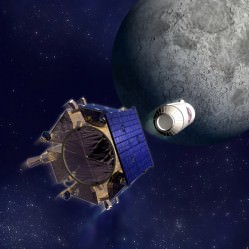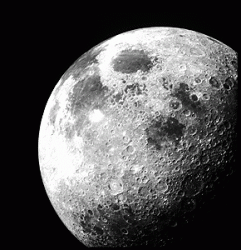[/caption]
The Lunar Reconnaissance Orbiter fired its braking thrusters for 40 minutes early today, successfully inserting the spacecraft into orbit around the Moon. Over the next several days, LRO’s instruments will be turned on and its orbit will be fine-tuned. Then LRO will begin its primary mission of mapping the lunar surface to find future landing sites and searching for resources that would make possible a permanent human presence on the moon. Also, early Tuesday, the companion mission Lunar Crater Observation and Sensing Satellite (LCROSS) sent back live video as it flew 9,000 km above the Moon, as it enters its elongated Earth orbit, which will bring it on course to impact the Moon’s south pole in October.
The two spacecraft reached the Moon four-and-a-half days after launch. LRO’s rocket firing began around 9:20 GMT (5:47 a.m. EDT) and ended at 10:27 GME (6:27 a.m. EDT), putting the spacecraft into an orbit tilted 30 degrees from the moon’s poles with a low point of 218 km (136 miles) and a high point of 3,000 km (1,926 miles). Over the next five days, additional rocket firings will put the spacecraft into the correct orbit for making its observations for the prime mission, which lasts a year — a polar orbit of about 31 miles, or 50 kilometers, the closest any spacecraft has orbited the moon.
Meanwhile, at 12:20 GMT (8:20 EDT) on Tuesday, LCROSS made a relatively close flyby of the Moon, sending back live streaming video. Watch the replay here.

LCROSS is now in its “cruise phase” and will be monitored by the mission operations team. During the flyby, the science team was able to obtain the data needed to focus and adjust the cameras and spectrometers correctly for impact.
LCROSS will never actually be lunar orbit, but is working its way to an elongated Earth orbit which will eventually bring it to the correct orientation for meeting up with the south pole of the Moon later this year. LCROSS will search for water ice on the moon by sending the spent upper-stage Centaur rocket to impact part of a polar crater in permanent shadows. The LCROSS spacecraft will fly into the plume of dust left by the impact and measure the properties before also colliding with the lunar surface.

